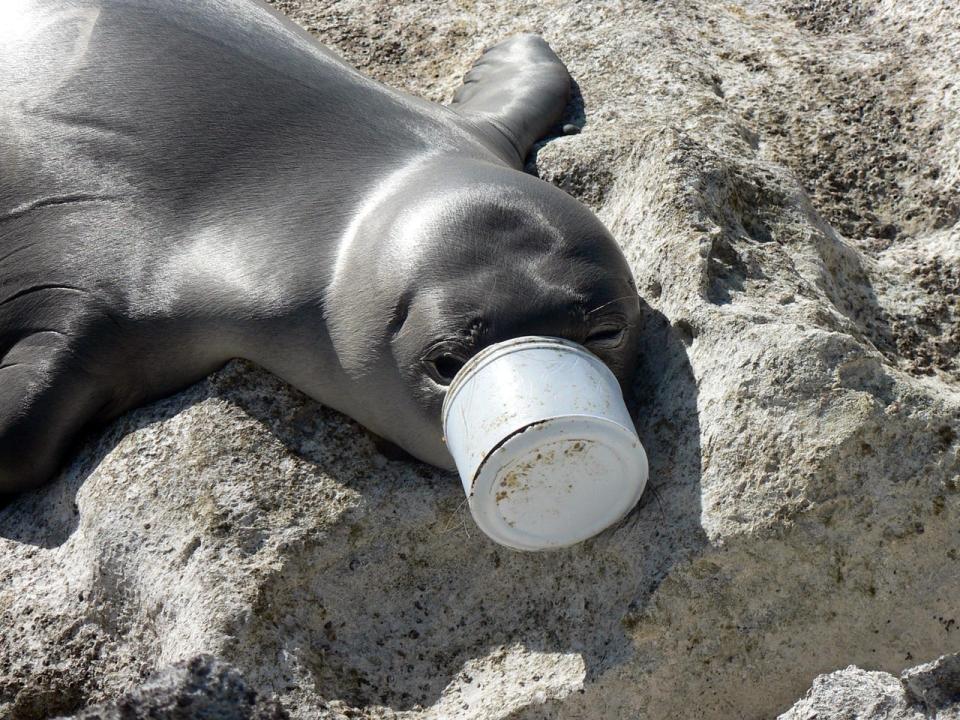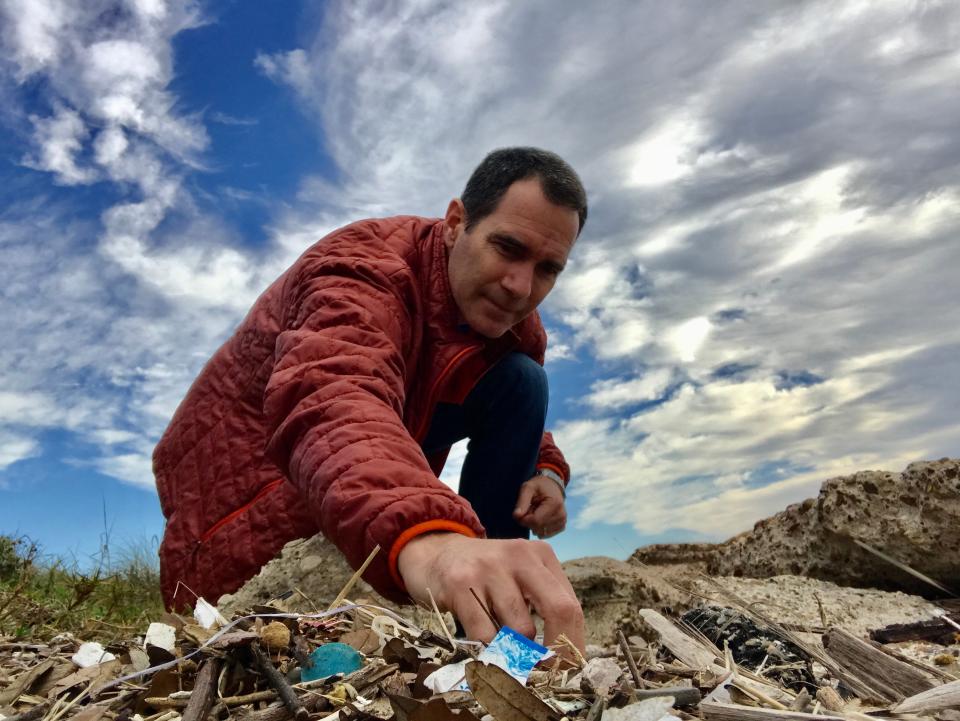'Choked, Strangled, Drowned': Report lays out severity of plastic harming endangered marine life
BARNSTABLE, Mass. – When Charles Innis, lead veterinarian at the New England Aquarium, cut into a 400-pound leatherback sea turtle that washed up dead on Sandy Neck in November 2015, he was looking for the cause of its demise, signs of disease or parasites.
What the necropsy team encountered was a 3-foot-square sheet of plastic lodged in the animal's stomach.
The turtle had experienced the worst that mankind could dish out. Deformities and X-rays revealed extensive fractures of the shell and vertebrae from a collision with a vessel. Heavy abrasions and lacerations around the front flippers indicated it had been entangled in fishing gear, the likely cause of death.
The plastic, which when floating in the water resembles the jellyfish that are the leatherback’s favorite food, would have killed it by blocking its intestine, Innis concluded.
From plastic netting and lines, down to the tiniest nanoplastics that can be eaten by zooplankton and enter the food chain, our seas are choking on plastic, and so are the animals who live there, according to a report released Thursday by the international ocean advocacy nonprofit group Oceana.
![A gull flies over a monk seal lying on a polluted beach on Laysan Island, part of the Papahnaumokukea Marine National Monument in the Northwestern Hawaiian Islands. A new report from the nonprofit agency Oceana outlines the impact that plastics pollution has on marine life. [Matthew Chauvin taken under NOAA permit 16632]](https://s.yimg.com/ny/api/res/1.2/uHXHzn9h5PAjfgYXMQz.Qw--/YXBwaWQ9aGlnaGxhbmRlcjt3PTk2MDtoPTY0MQ--/https://media.zenfs.com/en-us/usa_today_news_641/07a886ec0688318e59cea35acdd46247)
“It’s very depressing, just heart-wrenching, all of these stories of animal suffering,” said Kimberley Warner, a senior scientist at Oceana and lead author of the report that investigated nearly 1,800 documented cases from 21 states from 2009 to 2018.
The report, "Choked, Strangled, Drowned: The Plastics Crisis Unfolding in Our Oceans," said the cases represented far fewer than the actual number affected by plastics. Relatively few cases are reported, and many animals are too decomposed to determine why they died.
He posed as a doctor and a wilderness expert. Behind the facade was an accused child molester.
The report focused on marine mammals and sea turtles because they are the most likely species in which injury and death are reported and investigated. It found a total of 40 different species had either swallowed or been entangled in plastic debris, and 88% of those animals were federally listed as endangered or threatened with extinction under the Endangered Species Act. The report found that 90% of those cases involved the animal swallowing plastic. Bags, balloons, recreational fishing line, plastic sheeting and food wrappers were the most common.
In 2019, a report by Australian scientists estimated that 15 million tons of plastic enter the ocean each year, the equivalent to two garbage trucks per minute. This year, a report published in Science Magazine by Winnie Lau of Pew Charitable Trusts and others estimated a doubling of the amount of plastic that ends up in the world’s oceans by 2040.
'It's incredibly discouraging'
No life stage escapes harm, the Oceana report found, from sea turtle hatchlings who survive the treacherous gantlet of predators on their dash to the ocean from beach nests only to mistake floating plastic pellets for food and die, to whales who swallow large sheets of plastic. Sea turtles made up nearly half the reported incidents; manatees accounted for nearly 40%, followed by seals and sea lions, then whales.

Randy Wells has seen dolphins entangled in all kinds of things, from fishing line to a Speedo, during his years as the director of the Chicago Zoological Society’s Sarasota (Florida) Dolphin Research Program. He sees an increasing number of dolphins, manatees and turtles that have gotten entangled in fishing gear or have ingested plastic.
“It’s incredibly discouraging,” Wells said.
Robert Prescott, retired director of the Massachusetts Audubon Society’s Wellfleet Bay Wildlife Sanctuary, has done necropsies on sea turtles since the late 1970s. The Wellfleet sanctuary handles 200 to 1,200 sea turtles each fall and winter that strand on Cape Cod Beaches and suffer hypothermia.
Cape Cod: Cold-stunned sea turtles rescued from Massachusetts beaches
Initially, Prescott said, he didn’t see any plastics when conducting necropsies on dead sea turtles. That changed in the 1980s.
“Whenever you open up a leatherback, you see plastic,” Prescott said.
Seals are typically spotted entangled in fishing gear, plastic toys and other paraphernalia such as flying rings, cups or packing straps. Christine Hudak and Lisa Sette, researchers at the Center for Coastal Studies in Provincetown, found microplastics ranging in size from thousandths of inches to a quarter-inch in seal scat.
“We weren’t expecting it, or looking for it,” Hudak said.
Hudak and co-researcher Anna Robuck of the University of Rhode Island did find what they were looking for when they cut open 100 great shearwaters – large oceanic birds that plunge into the water from the air and swim down to snatch squid and fish – and found that 60% of adults and 98% of juveniles had plastic, mostly in their gizzards where indigestible items are broken down. These birds apparently mistook submerged plastic for prey.
Hudak is working on another project that goes down to the microscopic level, mining three decades of plankton samples collected by researchers at the Center for Coastal Studies while studying the zooplankton favored by endangered North Atlantic right whales.
Other studies have shown that zooplankton feed on tiny bits of plastic floating in plankton blooms. There is concern about the unknown effects of microscopic nanoplastics that can pass from the blood into tissues and get passed up the food chain to us.
“We don’t know the toxicity of the plastics we are ingesting,” Hudak said.
Researchers call for less plastic
The solution is not recycling but decreasing production, even if it has to be forced on plastics manufacturers, Warner said.
“Sadly, I think it will take bans rather than recycling,” she said. “There are too many things that aren’t able to be recycled, and recycled products are expensive, while virgin plastic is cheaper.”
Bans have demonstrated success at the local level, Warner said, and they have been gaining traction. The National Conference of State Legislatures noted 10 large cities enacted plastic bag bans, and 16 states and the District of Columbia placed some form of ban or restriction on single-use bags. The National Caucus of Environmental Legislators reported there were 230 pieces of legislation in 35 states this year addressing plastics pollution.
“The first question I hear is what will I substitute for this (plastics),” said Northeastern University economics professor Madhavi Venkatesan. Many people over 50 didn’t grow up with plastics in their home.
![A spinner dolphin on the leeward side of Maui, Hawaii, leaps out of the water draped in plastic. [Jackson Kowalski/Pacific Whale Foundation]](https://s.yimg.com/ny/api/res/1.2/xe5QmQOfpK4SSOQJdADPsw--/YXBwaWQ9aGlnaGxhbmRlcjt3PTk2MDtoPTY0Mg--/https://media.zenfs.com/en-us/usa_today_news_641/3c0901048208b984fe22b505088dea62)
Venkatesan spearheaded the ban of single-use plastic water bottles, town by town, on Cape Cod. Thirteen of 15 towns agreed to ban municipal use, and seven agreed to ban retail sales this fall.
“You have to start somewhere,” Venkatesan said. “Unfortunately, there is a loud minority who believes that freedom comes without responsibility. They are the reason we have to have bans. They will only do what they have to do.”
Plastics are big business
Decreasing production is not a popular topic with manufacturers. A woman answering the phone at the Manufacturers Association for Plastics Processors, which represents 400 companies and 45,000 employees, replied to a request for an interview with “We’re not interested, but thank you” and hung up.
A media representative at the Plastics Industry Association responded to a phone call and emails requesting an interview but did not return calls as of deadline Wednesday.
The Plastics Industry Association's annual report for 2020 revealed that the industry accounted for more than 1 million jobs and $432 billion in shipments in 2019. The plastic products segment of the industry was the eighth-largest industry in the USA, and manufacturing employment grew annually by 1.6% over the past seven years. The value of shipments grew by 1.1% annually during that same time period.
“That is how they make money, by making these products," said Jace Tunnell of the University of Texas Marine Science Institute, who is director of the Mission-Aransas National Estuarine Marine Research Reserve. "We might not like the plastic out in the environment, but people keep consuming it."

Tunnell worked with plastics manufacturers after a “nurdle” spill on Corpus Christi beaches in 2018. Nurdles are small plastic spheres that are the raw material of plastics manufacturing. They are the right size to be eaten by birds, sea turtles, fish and other marine animals, and environmentalists and scientists worry they could absorb toxins such as PCBs and DDT and bring them to humans through the food chain.
Research has shown that currents in the Gulf of Mexico, cycling past Mexico, deposit 10 times as much trash, more than 90% plastic, on Texas beaches than on those of other Gulf Coast states. Citizen scientists, organized by the research reserve, reported finding nurdles. The concentration of these reports pointed to a cluster of plastics manufacturers as the source.
Many of these manufacturers had signed on to an industry program of best practices known as Operation Cleansweep. The evidence showed companies did not adhere to that program, and legislation was created to have state permits for the industry conditioned on zero discharge of these pellets, Tunnell said.
U.S. Sen. Tom Udall, D-N.M., introduced a bill in September to address nurdles and tackled the larger problem of marine plastics with co-sponsor Rep. Alan Lowenthal, D-Calif., with the Break Free from Plastics Act requiring large plastics companies to take responsibility for plastic waste.
“The U.S is the largest generator of plastic waste in the world and one of the top three countries for plastic escaping into the ocean,” Oceana’s Warner said. “This is our problem, and these animals are off our shores, and this is something we need to address.”
Contributing: Dinah Voyles Pulver, USA TODAY
Follow Doug Fraser on Twitter: @dougfrasercct.
This article originally appeared on Cape Cod Times: Oceana report lays out how plastics harm endangered marine life

